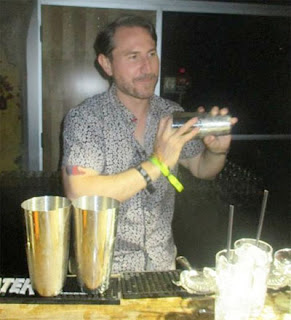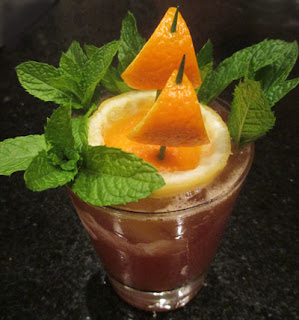
My first talk on Thursday last week at Tales of the Cocktail was entitled "All the Bar's a Stage: Performance, Bravado, and Theatricality in the Bar" hosted by Steve Schneider of Employees Only, Jack McGarry of Dead Rabbit, Julio Cabrera of Regent Cocktail Club, and Joe McCanta of Grey Goose. In figuring out my schedule, I was considering going to the seminar on flair since I lack any flashy cocktail game. Often times people comment that it looks like I am a scientist behind the bar, and well, it is hard to shake years of training. While I did not want to add a juggling routine, adding some extra panache to my tending could not hurt. So when I spotted this talk that covered this and many other less over the top flashy concepts, I figured that this was the right talk for me to hone in on.
Joe began the talk by explaining why we are discussing performance for it is not the drinks business, it is the experience business. He also riffed off of this famous quote:
I've learned that people will forget what you said, people will forget what you did, but people will never forget how you made them feel. -- Maya Angelou
If you insert things like "exact drinks" or "the bartender" into the quote, it is not hard to view the night out as entertainment; the third dictionary definition of entertainment is "the action of receiving a guest or guests and providing them with food and drink." Joe followed up that the job is people tenders, not bartenders.
In terms of flair, Steve came from a minor flair background with one of his early thirteen years doing tricks; however, a little tin spin can turn people's heads and elevate their experience. "If a movement catches the attention of the guest -- you've got them. And you gave them some sort of experience." While Jack described how his "Flair bartending career began and ended when I flipped a bottle and clipped a 50 inch tv," watching a video of him bartend shows a lot of captivating movements that can instill confidence in the guest. As Joe commented, engagement with the guest is the most important part of the job. The panel also pointed out that flair was nothing new and cited examples of Jerry Thomas and Harry Johnson being performers and utilizing flair.
Tiki culture took this engagement factor a step further for often drinks were being made behind swinging doors, and much effort was put into presentation, ambiance, and escapism. Indeed, it was important to hide the efforts that went into the drink. Moreover, Don the Beachcomber showed his concern for the guest by limiting the number of Zombies and other drinks they could have. "Zombies are like breasts: 1 is too few, 3 is too many, and 2 is just right."
The presenters then compared the job to a variety of other performers.
Actors make people believe and offer escapism. How a bartender presents themselves and dresses sets the stage for when guests enter the bar. Steve commented about the first time he walked into Employees Only and was in awe when he saw the uniforms especially how clean they were.
Magicians make people suspend their beliefs.
Comedians make people laugh; every bartender should know at least one joke. Moreover, perhaps blue drinks came back in classy hotel bars because it is funny.
Musicians make people listen, there is a separation between performer and spectator, and the performance is almost a ceremony.
Dancers make people watch, and all the movements behind the bars whether with the bottles and tools or the other bartenders can appear graceful and even choreographed.
Next, they discussed the five rules of the performer. One,
know your audience. At Dead Rabbit, the bar resembles a stage and the bartenders are encouraged to move and dress like actors. At Employees Only, behind the bar is elevated so not only is the bartender a bit taller, they can see the crowd. While Dead Rabbit's well is set up like a cockpit to ensure quick fluid movements with lots of eye contact, Employees Only is set up to make the bartenders move to get bottles and other ingredients so that they can interact with more guests throughout the night. The Employees Only service protocol also communicates that the guest is being taken care of. Give the guest a menu first especially when they first walk in - even if you are in the middle of making drinks; this buys you some time and makes sure they know they are in the queue. Once a drink order is taken, set the glass in front of them to tell the guest that this drink is for them and to tell your coworkers that the guest is being taken care of.
The second aspect is the
arc of the performance. Jazz musician Miles Davis used to have comedians open up for him because he knew it would help prepare the audience to be receptive to his more challenging musical performance. Overall, always leave the guest wanting more; do not under- or over-saturate them, but leave them wanting to come back. The third aspect is know the
tools at your disposal. Use the five senses to illicit emotions in the guest. Make it a rule to have every drink engage at least two of these senses. Remember that the choice of serving vessel can change the way a guest engages with your drink.
Four is
how trust is built. Offer recommendations. Keep the guest in a good zone by ordering enough but not too much (see Don's Zombie point above). And always have your perspectives as what is right for you is not necessarily right for the guest. Even if you see absinthe and egg whites every day at work, it is incredibly novel for people. Try to relate and keep your frame of reference. Jack commented that trust is built not by being defensive but by being on the side of the guest to provide the ultimate experience. Furthermore, Steve added that hospitality is making people feel safe which includes people around the guest such as the asshole next to him. And finally five,
how to be prepared. Calibrate before the shift to be ready. Train yourself and train your movements to appear effortless. Grooming before the shift and looking your best is crucial. And know your bar, know your spirits, and know your drinks.
One final quote that I left out early was when the panel was describing one word to describe bartending, Steve said patience for "Drunk people are crazy... it takes a lot to relate to them."



 The final talk I attended at Tales of the Cocktail this year was given by a father-daughter duo, namely bartender Pamela Wiznitzer and her dad, autism specialist Dr. Max Wiznitzer. The talk was entitled "Brains & Booze: The Neurology of Mixology." While a lot of the talk was an overview of the brain and sensing organs, I will focus on the regions of overlap that are specific to cocktail appreciation.
The final talk I attended at Tales of the Cocktail this year was given by a father-daughter duo, namely bartender Pamela Wiznitzer and her dad, autism specialist Dr. Max Wiznitzer. The talk was entitled "Brains & Booze: The Neurology of Mixology." While a lot of the talk was an overview of the brain and sensing organs, I will focus on the regions of overlap that are specific to cocktail appreciation.






 The theme for this month's
The theme for this month's 






















 The 2017 collection of 855 drink recipes, bartender tributes, and essays on hospitality from CocktailVirgin's Frederic Yarm. Available at
The 2017 collection of 855 drink recipes, bartender tributes, and essays on hospitality from CocktailVirgin's Frederic Yarm. Available at  The 2012 collection of 505 drink recipes, techniques, and Boston bar recommendations from Frederic Yarm. Available at
The 2012 collection of 505 drink recipes, techniques, and Boston bar recommendations from Frederic Yarm. Available at 




